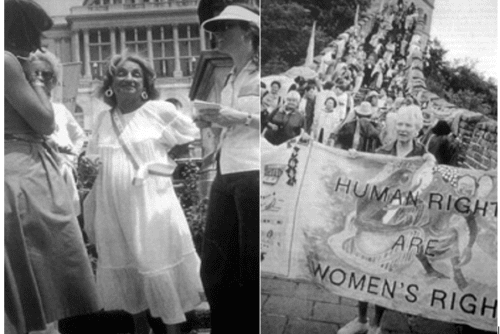From the 1930s through the 1970s, first eugenics and then the Cold War made “overpopulation” a key word in defining the nature and cause of “Third World” poverty, as well as what the form of its solution—development—would be. Defining fertility as the problem simultaneously decentered blame—it was not colonialism or extractive world economic systems that cause poverty in the Global South—and provided a very specific cause and site of intervention: irresponsible, careless mothers and their excessive children. We know this story well; many feminist scholars and activists have made the argument that this discourse, imagined in relationship to the social science unit of the national population, was crucial to the elaboration of twentieth-century biopolitical regimes of post/neo/colonial governance.1
Since about the mid-1980s, though, the discourse of overpopulation has become largely residual, like eugenics, and sometimes the nation (although all retain considerable potency when deployed in specific contexts). As neoliberalism and structural adjustment policies have replaced development in remaking the global economy, with all that means about who lives and who dies, and under what material circumstances (including in Europe and the United States), these other discourses have fractured as well. Eugenics has been replaced by criminalization and geneticization. The nation has remained the unit of border security while simultaneously being supplanted at the level of empire by the “war on terror,” the corporation, and international financial regimes. Overpopulation, I will argue, has been replaced by adoption as the symbol of a new kind of reproductive governance in the aftermath of this shattering of the scientific and social scientific, Keynesian, developmentalist consensus.
I am borrowing the term “reproductive governance” from Lynne Morgan and Elizabeth Roberts, who have suggested that we note a shift, particularly in Latin America, from a liberal discourse of overpopulation to the transnationalization of the US Christian right and Catholic culture wars.2 They argue that the culture wars—in the Americas and beyond—have promoted a new kind of political actor, the unborn, who conspicuously are carrying more rights than transnational labor migrants, who are subject to vicious regimes of “security” and criminalization across the Americas.3 The same conservatives who so loathed the discourses of human rights in the context of anti-Communist civil wars are now taking up a language of the “right to life” of the unborn, which is pitted against other kinds of rights claims—reproductive, sexual, indigenous, and natural rights. In this piece, I extend their argument by looking at Guatemala in particular and the celebration of international adoption in general as embedded in this regime of rights. I suggest that adoption has supplanted birth control and sterilization in the US imperial imaginary, that it is a key, anchoring part of a new regime of reproductive governance. Further, I want to highlight the ways the new regimes of rights still disallows human rights claims, at least when they come from impoverished mothers rather than fetuses, and that criminalization and geneticization have been a bulwark of a scientific—or at least scientized—defense of the neoliberal order of things.
Overpopulation
Overpopulation was always a rhetoric of rule, an explanation of what was wrong with a “them,” and their need for “our” intervention. The United States was a key player in its elaboration, and just as Guatemala provides an exemplary case for studying adoption, Puerto Rico was central to the development of a discourse of overpopulation. As I have argued elsewhere, in the 1930s, the island was one of the first places that demography, newly emerging as a policy science, turned its attention. It is worth recalling how that discourse operated. In one of its early iterations, Theodore Schroeder, a controversial popularizer, made the case in 1932 in the pages of Margaret Sanger’s Birth Control Review for overpopulation as a concept, singling out Puerto Rico in a way that proved exemplary. The island, he argued, suffered acutely from unemployment, lack of educational opportunity, homelessness and inadequate housing, and disease. Although this certainly described conditions on the island at the disastrous heights of the Depression—following the collapse of revenues from the monocultural economies of sugar along the coast and coffee in the mountains, after the massive separation of Puerto Ricans from their land, compounded by the devastating San Ciprian hurricane that year—the concerns that provoked Schroeder’s article were neither environmental nor economic. On the contrary, he claimed that Puerto Rico’s problems were “not due to temporary causes,” but were “normal” for the island. Instead he insisted, that the problem was “overpopulation”—claiming that the land was not feeding the people, inventing a subsistence agriculture that had not existed since before the era of colonization and slavery—and US public health interventions that he claimed had lowered the death rate (they had not).4
Fortunately for the edification of the readers of the Birth Control Review, a member of the Puerto Rican Nationalist Party, José Enamorado Cuesta, shot back a rejoinder in the next issue, objecting that:
[Schroeder] does not tell your readers that it is directly at the door of American capitalism that the blame must be laid for everything that is wrong in Porto Rico today […] He does not tell that in thirty-four years of American intervention, by a drastic process of legalized assault the people have been dispossessed of their land and brought to the condition of paupers […] Our real problem lies in the actual control by American capital of practically all our wealth.5
This account of capitalist dispossession unfortunately did not capture the policy imagination in the same way that “overpopulation” did. In subsequent years, Puerto Rico provided the United States with a laboratory in which to test interventions, from sterilization to birth control pills, and in which to conduct countless sociological studies measuring Puerto Rican women’s supposed resistance to using birth control—even though the evidence suggested that, on the contrary, Puerto Rican women and men were using birth control and surgical sterilization in surprisingly high numbers, and the crucial issue may well have been a paternalist refusal by mainland advocates of “overpopulation” to make effective birth control, including the diaphragm, available on the island.
The success of overpopulation discourse was only made possible in a context where eugenics was a dominant language of policy and science. After all, most people understood that densely populated areas like cities were engines of economic growth, and sparsely populated areas like sub-Saharan Africa suffered significant economic challenges as a result of their lack of density. The areas of the world with greatest population density were also some of the wealthiest; low population density correlated with poverty. Overpopulation discourse relied for its logical underpinnings on notions of the large families of the poor, images popular among right-wing racist eugenicists like Harry Laughlin, who advocated immigration restriction of southern and eastern Europeans, and testified in Buck v. Bell that Carry Buck was a good candidate for sterilization because she was part of “the shiftless, ignorant, and worthless class of antisocial whites of the South.”6 Equally, though, eugenics made sense to those on the antiracist left like W.E.B. DuBois, with his unfortunately famous comment that “The great mass of ignorant Negroes still breed carelessly and disastrously.”7 This almost aesthetic revulsion against the large numbers of the poor is reproduced in numerous popular accounts of overpopulation, from William Vogt’s Road to Survival to Fairfield Osborn’s Our Plundered Planet, which in 1948 passed the torch from the post-Nazi discrediting of eugenics to the new work on overpopulation. This discourse culminated in the opening pages of Paul Ehrlich’s 1968 Population Bomb, a bestseller whose popularity renewed the policy urgency of overpopulation for the 1960s. There, he describes a taxi ride through the slums of Delhi awash in refugees from the Punjab, although he overlooks the political causes of the crowded streets:
The streets seemed alive with people. People eating, people washing, people sleeping. People visiting, arguing, and screaming. People thrusting their hands through the taxi window, begging. People defecating and urinating. People clinging to buses. People herding animals. People, people, people, people. As we moved slowly through the mob, hand horn squawking, the dust, noise heat, and cooking fires gave the scene a hellish aspect […] All three of us were, frankly, frightened.8
Overpopulation discourse echoed the unit of analysis of eugenics—the national population—and while on the surface it appeared to drop the concern about the “quality” of that population that was the hallmark of eugenics, it also clearly echoed its worries about the masses of the poor. In so doing, a slightly peculiar social science discourse took up the mantle of the “hard” sciences to produce a powerful policy science.
As many have shown, on a world stage, the “population bomb” exploded as an ideology after 1945, as the United States used overpopulation and family planning in concert to provide the diagnosis and the interventionist cure for Third World poverty, conveniently overlooking both capitalism and colonialism as it took the reigns of Britain’s collapsing empire and launched a new era of US global dominance, not to say imperialism. When Truman launched the policy that later came to be called “development” in 1949, it foregrounded technical assistance to agriculture, industrialization, and birth control. Small families were offered as one of the technologies that could lift a Third World economy into prosperity. Piloted in Puerto Rico, population control became a cornerstone of US foreign policy from 1950 through the 1970s. While the United States was napalming the Vietnamese countryside and herding its people into “strategic hamlets,” it was also handing out birth control pills. Governments from South Asia to Latin America were provided with encouragement, method, and means to implement mass sterilization programs. In India, for example, a vasectomy program that offered land or loans in exchange for men agreeing to sterilization provoked international outcry (even as the much more complicated tubal ligation operation in women was vastly more common). As a result of this US policy and its ready adoption by elites transnationally—people who had always thought the poor reproduced disastrously—birth control, sterilization, and population limitation came to stand for modernity, development, and allegiance to US anti-Communist goals.
- See Linda Gordon, “Birth Control and Women’s Rights” The Moral Property of Women: A History of Birth Control Politics in America (Chicago: U of Illinois P, 2002); Laura Briggs, Reproducing Empire: Race, Sex, Science and the U.S. Imperial Project in Puerto Rico (Berkeley: U of California P, 2002); Ann Filemyr, “Unmasking the Population Bomber: Analyzing Domination at the Intersection of Gender, Race, Class, and Ecology,” NWSA Journal 9.3 (1997); Andy Smith, “Women of Color and Reproductive Choice: Combating the Population Paradigm,” Journal of Feminist Studies in Religion 11.2 (1995); Renu Dube, Reena Dube, and Rashmi Bhatnagar, “Women Without Choice: Female Infanticide and the Rhetoric of Overpopulation in Postcolonial India,” Women’s Studies Quarterly 27.1-2 (1999); Betsy Hartmann, Reproductive Rights and Wrongs: The Global Politics of Population Control, rev. ed. (Boston: South End Press, 1999). [↩]
- Lynn M. Morgan and Elizabeth F.S. Roberts, “Reproductive Governance in Latin America,” Anthropology & Medicine 19.2 (2012): 241–254; Elizabeth L. Krause and Silvia De Zordo, “Introduction. Ethnography and Biopolitics: Tracing ‘rationalities’ of Reproduction Across the North–south Divide,” Anthropology & Medicine 19.2 (2012): 137–151. [↩]
- Lauren Berlant helpfully points out that beginning with the Reagan administration, fetuses and corporations became the United States’ ideal citizens. The Queen of America Goes to Washington City: Essays on Sex and Citizenship (Durham: Duke UP, 1997). [↩]
- Theodore Schroeder, “Porto Rico’s Population Problem,” Birth Control Review (1932): 71-72. The anglicized spelling, “Porto Rico,” was imposed with the US occupation, and used from 1898-1932. [↩]
- José Enamorado Cuesta, “Porto Rico’s Real Problem,” Birth Control Review (May, 1932): 157. [↩]
- Quoted in Dorothy Roberts, Fatal Invention: How Science, Politics, and Big Business Re-create Race in the Twenty-first Century (New York: The New Press, 2012): 40. [↩]
- W. E. B. DuBois, “Black Folk and Birth Control,” Birth Control Review (June 1932). [↩]
- Paul R. Ehrlich, The Population Bomb (New York: Buccaneer Books, 1995): 1. [↩]




